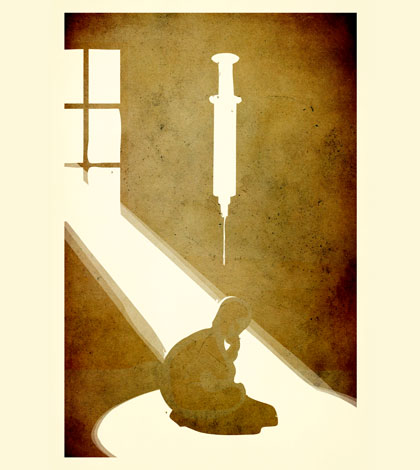 Superstorm Sandy has plunged many recovering drug abusers into a personal darkness eclipsing even that of the power blackouts left in its wake.
Superstorm Sandy has plunged many recovering drug abusers into a personal darkness eclipsing even that of the power blackouts left in its wake.
“Reality hit me and I realized I don’t have any real friends, I’ve been f***** stranded on the street,” Jennifer, a recently re-arrested drug abuser whose name was changed to protect her identity, writes in an online plea for help. “Gimme a reason to keep on living.”
Hers is just one of countless similar stories of compounded despair that emerged, then snowballed, after the historic Oct. 29 hurricane.
Far from the camera glare cast on heroic nurses who evacuated newborn babies from the Sandy-crippled NYU Langone Medical Center in Manhattan at the height of its wrath, local drug rehab facilities faced similarly Herculean tasks in fighting a surge of relapses among patients. Three months later, treatment providers who were already unable to meet the demand of LI’s drug epidemic warn of a coming wave of additional substance abuse cases, sparked by the widespread trauma still reverberating throughout the region and among those in addiction’s grasp. The new onslaught strikes as many of the region’s addiction treatment services are still on life support due to the damage they sustained and others remain shuttered—such as the Long Beach Medical Center, one of LI’s main detox centers, which is closed through March.
“Like any other crisis, if things were not good before the crisis, the crisis will make things worse,” says Jamie Bogenshutz, executive director of Massapequa-based YES Community Counseling Center and president of the Nassau Alliance of Addiction Services, a rehab umbrella group. “The crazier life becomes for people, it becomes more obvious there are not enough resources.”
Studies show illicit drug use spikes in the aftermath of natural disasters. Adults who were displaced from their homes for more than two weeks after Hurricane Katrina—the one storm more damaging than Sandy—had increased drug use, more mental health issues and unmet treatment needs, according to the National Survey on Drug Use and Health.
In New York, 40,000 were displaced after Sandy. Providing them and others with Psychological First Aid are 17 LI mental health agencies among 35 statewide deploying 1,000 door-to-door crisis counselors as a part of “Project Hope.” The Federal Emergency Management Agency awarded $8.2 million to the New York State Substance Abuse and Mental Health Services Administration, which allocated $1.8 million to Nassau and nearly $1 million to Suffolk in November for the program, which runs nine months.
“The enormity of the personal challenges and material loss experienced has overwhelmed the usual coping capacities of most people,” said Dr. James Dolan, director of the Nassau County Office of Mental Health, Chemical Dependency and Developmental Disabilities Services, in a statement.
That includes previously sober superstorm survivors self-medicating with drugs or alcohol to deal with catastrophic losses of their homes, vehicles and belongings, as well as pre-Sandy substance abusers who’ve upped their doses to cope.
AFTER SANDY
With trains, gas, power and phone service largely unavailable in the days, weeks and even months after Sandy, an untold number of Long Islanders with heroin or prescription-drug dependencies were unable to meet their dealers and went into withdrawal—in some cases, revealing hidden addictions to their unwitting families.
“You had a whole bunch of young people literally hiding in their basements going through withdrawal, and their parents thought it was the flu,” says Jeffrey Reynolds, executive director of the Long Island Council on Alcoholism and Drug Dependence [LICADD]. He recalls a client telling him, “A few days in the house with no lights, no power, no heat, and the demons are bound to come knocking—and, boy, did they.”
Many of those who were getting help found themselves displaced from blacked-out inpatient substance-abuse facilities or cut off from outpatient service providers, who were often dealing with their own stormy troubles at home. The severity of the fallout for this particularly unstable and vulnerable population varied.
“Some of those people were disengaged from treatment; they have been almost impossible to get back,” says David Cohen, director of Outpatient Addiction Services at Eastern Long Island Hospital in Riverhead and president of the Quality Consortium of Suffolk County, another rehab umbrella group. He’s most concerned with chemically dependent patients he describes as “pseudo homeless”—those one step from the streets.
For others in treatment, the disruption was relatively minimal, such as those at the Phoenix House Hauppauge Center Men’s Program—though residents were moved to the Phoenix House Brentwood Campus for one day until the power was restored at the Hauppauge facility.
Stories of doctors making house calls—or in some cases, shelter visits for displaced patients—were also commonplace in the immediate aftermath as providers desperately sought not to have their clients’ recovery undone by the storm’s disruption, considering the difficulty of getting many into rehab to begin with.
“If they couldn’t make it to us, we were going to get it to them,” Christina Noonan, program director of the Huntington outreach facility for Daytop Village, Inc., says of her staff’s doctor delivering Suboxone to clients despite blocked and flooded roads. “He somehow found a way.”
Not everyone in recovery was as lucky. A Daytop facility in Far Rockaway was forced to release 150 court-mandated patients onto the streets west of the Nassau-Queens line after the New York State Office of Alcohol and Substance Abuse Services stalled patients’ transfer to upstate Daytop facilities, the New York Daily News reported.
Some from the Rockaways joined those from LI’s ravaged South Shores, packing mental health wards as a spike in substance abusers became suicidal—along with people without prior mental health diagnoses.
“We were full, full to capacity for the first two months,” says one LI psychiatric nurse who asked that neither she nor her employer be identified in order for her to speak freely. “There was an increase in suicidal patients because they could not get their medication or because the pharmacies were closed or a lot of addicts who had no place to go.”
THE COMING STORM
Local substance-abuse professionals and anti-drug advocates worry that having the additional Sandy-inspired substance abusers referred to the already overburdened inpatient and outpatient treatment facilities limited by government austerity measures is a prescription for failure.
Bogenshutz of YES says Project Hope, while beneficial, will ultimately “unearth the next layer of issues” that will require additional resources.
“We just don’t know how far-reaching the demand for services is going to go,” concurs Joe Smith of Long Beach Reach, which has joined Project Hope and has been treating patients spilled over from the still-shuttered Long Beach Medical Center. “The resources are limited already…it’s really eaten into the safety network.”
Before the storm, Nassau cut funds to youth groups involved in anti-drug counseling last year, and Nassau University Medical Center replaced some of its detox beds with outpatient care. Post-Sandy, LBMC’s repair costs are estimated between $32 million and $56 million—although hospital officials are reportedly prioritizing their rehab’s reopening.
LBMC representatives did not respond to requests for comment, but Patricia Hacken, director of alcohol and substance abuse services at the hospital, told the Press last summer that LBMC had applied to double its detox beds from eight to 16 because of a “significant increase” in requests for inpatient care.
“It is a significant loss, and I don’t necessarily see anybody picking up the slack,” says LICADD’s Reynolds, who fears the treatment gap will force some into “do-it-yourself detox,” which “isn’t a winning formula for most people.”
Smith, whose offices were not damaged in the flooding but finally got power and heat back the day after Thanksgiving, expects the surge of additional people seeking treatment to last into next year.
“We know from past experience that in the aftermath of disasters the surge in demand for treatment begins…three to six months after,” he says. “That surge in demand lasts for quite some time.”
Others interviewed for this story were optimistic that some of the recently approved Sandy aid funds will eventually be allocated to help fill the gap in post-Sandy substance-abuse services.
“Not surprisingly was that folks most impacted by the storm were somewhat isolated,” says John Cappola, president of the New York State Association of Alcohol and Substance Abuse Providers. “It took a while before we had a sense of how people were doing out there…I’m hoping that we learned a lot from this.”
New York State residents experiencing emotional distress as a result of Hurricane Sandy can access free, confidential crisis counseling 24/7 by calling LifeNet at 800-543-3638.


























